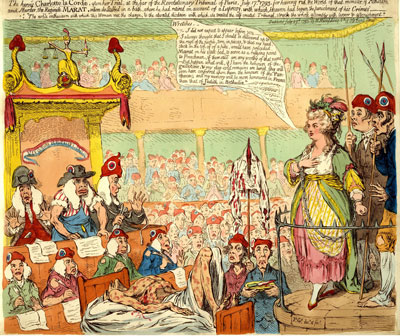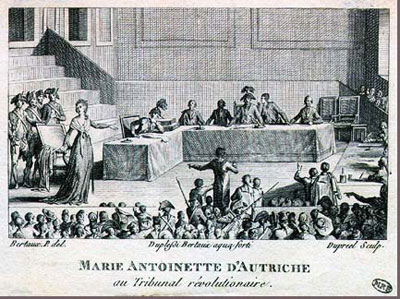The Heroic Charlotte La Cordé. . .
The impetus for this print was the British newspaper and magazine coverage of the trial and execution of Charlotte Cordé (1768-1793) for the assassination of Jean-Paul Marat (1743-1793) on July 14 and the state funeral for Marat that followed.

© Trustees of the British Museum
Marat was an influential journalist and politician, whose writings, Cordé and many others believed, had incited the violence of the "September Massacres" which resulted in the slaughter of as many as 1500 prisoners in Parisian jails. Consequently, although a hero to the radical Montagnards and sans culottes, Marat was hated by moderates and Girondists like Cordé who regarded him as a polarizing figure, whose views threatened civil war and a betrayal of republican ideals.
The print purports to show Cordé at her trial before the Revolutionary Tribunal. Cordé, of course, is idealized; the French judges and spectators are caricatured. The extended title reflects this obvious bias.
The heroic Charlotte La Cordé, upon her trial, at the bar of the Revolutionary Tribunal of Paris, July 17th 1793, for having rid the world of that monster of Atheism and Murder, the Regicide Marat, whom she Stabbed in a bath, where he had retired on account of a Leprosy, with which, Heaven had begun the punishment of his Crimes. The noble enthusiasm with which this Woman met the charge, & the elevated disdain with which she treated the self created Tribunal, struck the whole assembly with terror & astonishment.
Accounts of the trial and funeral began to appear in a variety of British newspapers as early as July 22, eight days after Cordé's arrest. They included articles in Lloyd's Evening Post, The Evening Mail, the London Star, the Morning Chronicle, the London Free Mason Magazine, and the Edinburgh Advertiser. We can be virtually certain that Gillray consulted at least the Lloyd's Evening Post for Wednesday, July 24 to Friday July 26 because it is the only account that records Cordé's name as "La Cordé" as he does.
But it is likely that Gillray used several sources, picking and choosing details from them that best suited his satiric purposes. In Lloyd's Evening Post (July 24) he would have read that Marat's funeral procession included "his shirt, stained with blood" and "a wooden bedstead, upon which the corpse of Marat was carried." So to make the visual connection between the assassination and the trial, Gillray includes the bloody shirt and the bed (with Marat still on it) in the courtroom for all to see. And just for good measure, Gillray adds the murder weapon—the bloody knife.
In the London Star (July 25) Gillray could have seen Marat's skin condition described as "a leprosy." And in that account (significantly by the French painter Jacques-Louis David) it is given as the reason for making sure that Marat's body is covered during his funeral procession. But, of course, in Gillray's print, the condition is, if anything, highlighted so that it can be portrayed as well-deserved retribution for Marat's monstrous crimes.
In Lloyd's Evening Post Wednesday, July 24 to Friday July 26, he would also have found a source for his portrayal of Cordé's general demeanor and the reactions of the revolutionary audience.
Charlotte la Cordé, who, according to her own words, rid the world of a Monster, was tried yesterday for the murder of the Friend of the People [Marat] by the Revolutionary Tribunal. Her countenance displayed heroic disdain; and her answers, by their boldness, struck every spectator with astonishment.
Finally, in several available sources, including the London Free Mason Magazine, The Evening Mail, and Lloyd's Evening Post Gillray could have found Charlotte's heroic address to her accusers, which he includes verbatim in the central speech bubble, adding only the first word, "Wretches."
Wretches
I did not expect to appear before you - I always thought I should be delivered up to the rage of the people, torn in pieces, & that my head, stuck on the top of a pike, would have preceded Marat on his state-bed, to serve as a rallying point to Frenchmen, if there still are any worthy of that name. - But happen what will, if I have the honours of the guillotine, & my clay-cold remains are buried, they will soon have conferred upon them the honours of the Pantheon; and my memory will be more honoured in France than that of Judith in Bethulia.
Gillray takes the most liberties in his portrayal of the Tribunal basing its appearance more on the British House of Commons than the Tribunal itself. Here, for instance, is a more or less contemporary image of the Tribunal at work a few months later during the trial of Marie Antoinette.

© This is Versailles
According to Wikipedia the Tribunal
was composed of a jury of twelve.. . . It had five judges, a public prosecutor, and two deputy prosecutors, all nominated by the Convention; and from its judgements, there was no appeal.
In Gillray's print, the public prosecutor is (appropriately enough) a butcher. His deputy prosecutors are a barber and a tailor. The judges (we can see only four) are interrupted in their note-taking by the power of Cordé's speech. But most are portrayed as dumb, dumber, or dumbfounded.
Sources and Reading
- Commentary from the British Museum on The Heroic Charlotte La Corde. . .
- "Charlotte Corday," Wikipedia
- "Jean-Paul Marat," Wikipedia
- "September Massacres," Wikipedia
- "Revolutionary Tribunal," Wikipedia
- Thomas Wright and R.H. Evans, Historical and Descriptive Account of the Caricatures of James Gillray #105.
- Thomas Wright and Joseph Grego, The Works of James Gillray, the Caricaturist; With the History of His Life and Times, p. 174.
Comments & Corrections
NOTE: Comments and/or corrections are always appreciated. To make that easier, I have included a form below that you can use. I promise never to share any of the info provided without your express permission.